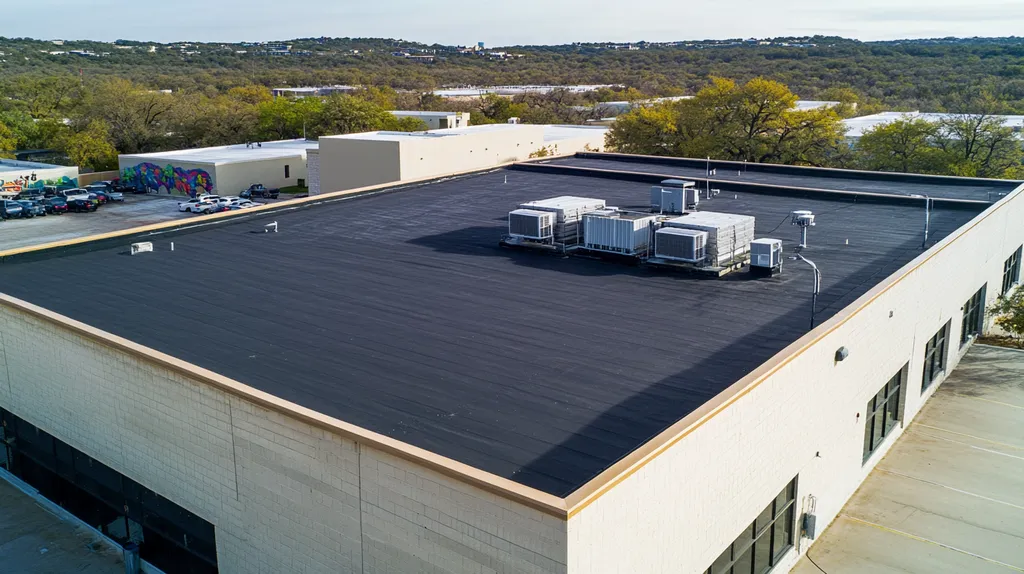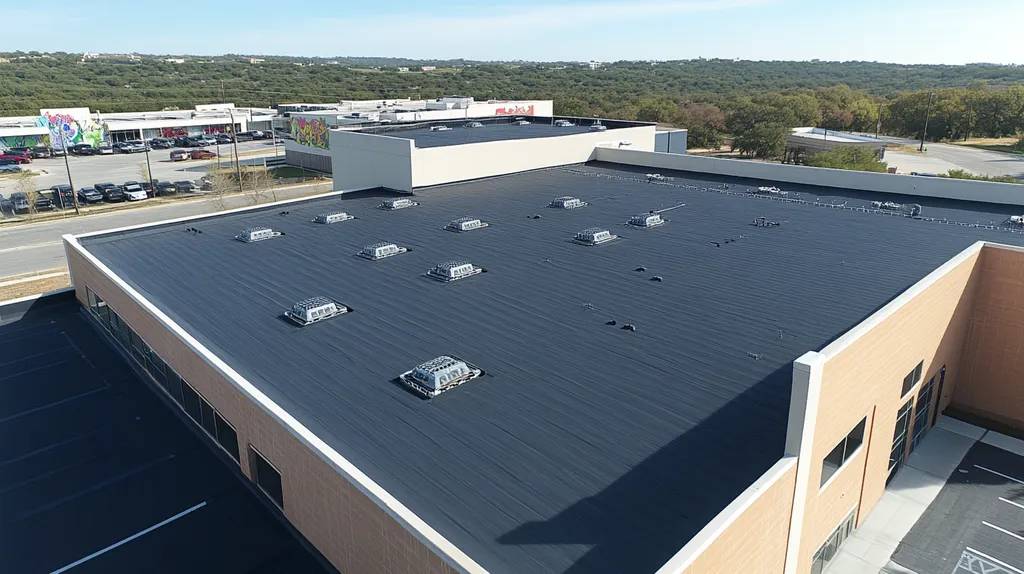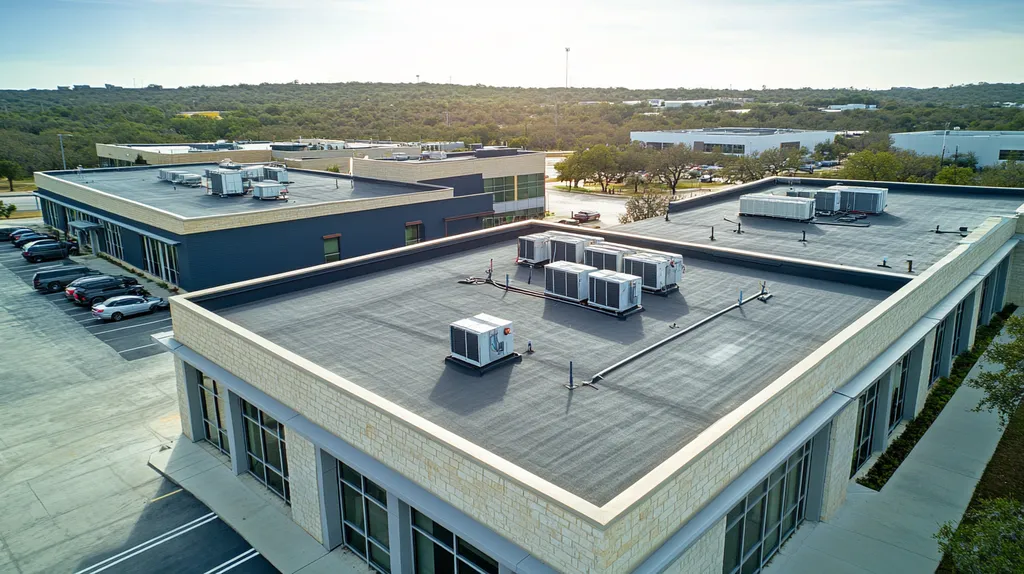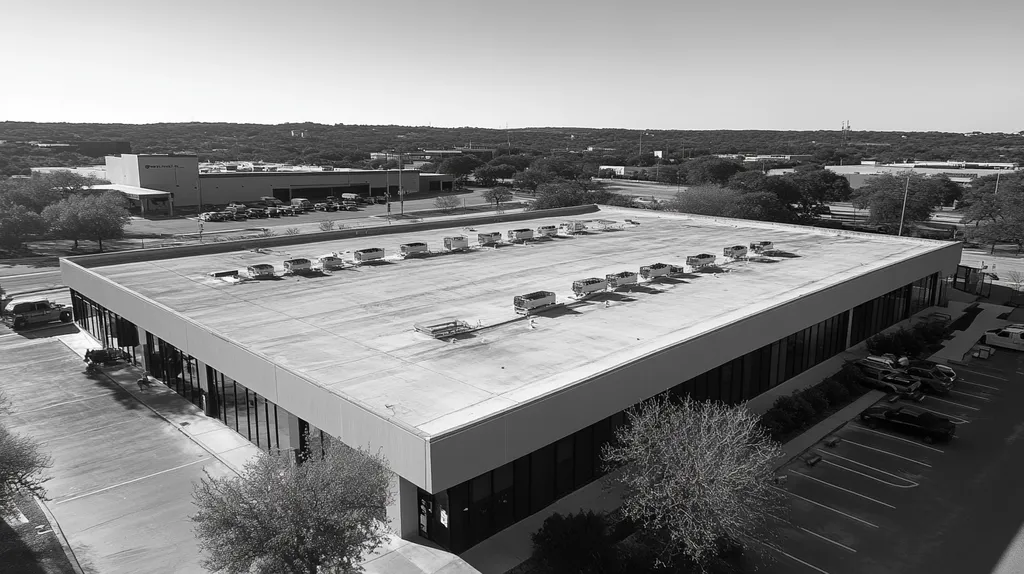Rising energy costs are forcing facility managers to confront an urgent reality: up to 40% of a building’s energy loss occurs through poorly maintained or outdated roofing systems, resulting in thousands of dollars in preventable expenses annually.
By implementing targeted energy efficiency measures in commercial roofing, organizations can reduce HVAC loads by 15-25% while extending roof lifespan by up to 10 years.
This comprehensive guide examines critical factors affecting roofing energy performance, from material selection and installation practices to compliance requirements and long-term maintenance strategies.
SECTION 1: PERFORMANCE FACTORS
As energy costs continue to rise and environmental concerns grow, enhancing energy efficiency in commercial roofing has become crucial. Research indicates that nearly 30% of a building’s energy use is linked to its roofing system. Key performance factors like thermal insulation, reflective roofing materials, and effective ventilation can dramatically influence ongoing operational expenses and contribute to a more sustainable future. This section delves into these essential factors and emphasizes their role in achieving energy-efficient roofing systems.
Thermal Insulation and R-Value Assessment
Thermal insulation is vital for maintaining a comfortable internal temperature in any building. The R-value measures the effectiveness of insulation, showing how well it resists heat flow. A higher R-value indicates better insulation performance, which translates to lower heating and cooling costs. Without adequate insulation, buildings can face energy expenses of up to 50% more, underscoring the need for regular R-value assessments.
Conducting an R-value assessment helps identify areas requiring enhancement. Older roofing materials might have lower R-values due to wear and tear. Upgrading to contemporary insulation options can yield substantial long-term savings and improve occupant comfort.
Advanced materials like spray foam or rigid board insulation can significantly boost R-values. Facility managers should prioritize proper installation techniques; even minor air leaks can diminish insulation efficiency and waste energy. By addressing thermal insulation, organizations can lower costs while supporting sustainability efforts by reducing their carbon footprint.
Key Action Items
Reflective and Cool Roofing Materials
Selecting the right roofing materials is essential for maximizing energy efficiency. Reflective and cool roofing materials are engineered to reflect more sunlight than traditional dark roofing options, significantly reducing heat absorption. This, in turn, lowers cooling demands during hot summer months.
Studies indicate that cool roofs can lower indoor temperatures by as much as 15 degrees, leading to noticeable energy savings. In sun-drenched areas, reflective materials can quickly pay off by lowering air conditioning expenses.
Roofing options such as white membranes, coated metals, and reflective shingles are readily available and can often be applied to existing structures. Facility managers should consider these materials for their immediate benefits and long-term investment in energy efficiency.
Implementing cool roofing technologies not only boosts energy efficiency but can also enhance the lifespan of the roof by minimizing thermal strain. This proactive choice is critical for facility managers eager to optimize building performance (source: U.S. Department of Energy).
Key Action Items
Roof Ventilation and Heat Dissipation
Proper roof ventilation is a crucial yet often overlooked factor in energy efficiency. Effective ventilation allows for heat dissipation, preventing excessive heat buildup that can increase cooling costs. Inadequate ventilation can lead to roof damage caused by trapped heat and humidity, resulting in costly repairs.
Implementing ridge vents, soffit vents, or powered ventilators can significantly improve airflow and temperature balance on the roof surface. By maintaining this balance, the load on HVAC systems is reduced, enhancing overall energy efficiency.
Furthermore, proper ventilation can extend the lifespan of roofing materials. By managing moisture levels, facility managers can avert problems such as mold growth, which jeopardizes structural integrity. The combined advantages of enhanced energy efficiency and decreased maintenance costs highlight the necessity of effective roof ventilation.
Key Action Items
SECTION 2: FINANCIAL CONSIDERATIONS
The rising cost of energy is a pressing issue that can significantly affect a facility’s budget. With commercial buildings consuming nearly 30% of the total energy used in the United States, maximizing energy efficiency has never been more urgent. For property managers, grasping the financial implications of roofing choices is essential. This section will examine energy cost analysis, available incentives, and the return on investment (ROI) for roofing upgrades.
Energy Cost Analysis and Savings Estimation
Conducting a thorough energy cost analysis is the first vital step towards identifying potential savings. This analysis involves scrutinizing current energy expenditures against roofing performance. For example, facilities with outdated roofs might face energy costs up to 20% higher compared to those with modern, energy-efficient options.
By comparing the thermal performance of existing roofs to energy-efficient alternatives, facility managers can estimate possible savings. Utilizing reflective roofing materials can result in notable cooling cost reductions, potentially lowering energy consumption by 10-30%.
Monitoring energy use after upgrades is essential for discovering ongoing savings. Analyzing monthly energy bills can highlight trends and pinpoint areas for further improvement. This data-driven approach ensures more informed decision-making and can lead to significant budget gains.
Key Action Items
Incentives and Rebates for Energy Efficiency
Numerous government and utility programs provide incentives to encourage energy-efficient upgrades. These incentives can significantly offset initial costs associated with roofing improvements. Common incentives include tax credits, rebates, and grants specifically for deploying energy-efficient materials and systems.
For example, the Federal Energy Management Program (FEMP) outlines qualifying projects that can receive financial incentives. Facilities upgrading to Energy Star-rated roofing often qualify for substantial rebates, further enhancing budget feasibility.
Local energy providers may also offer rebate programs, adding more funding options. By leveraging these incentives, facility managers can pursue energy efficiency without straining their budgets. Understanding and actively seeking these opportunities is key to making cost-effective roofing upgrades.
Key Action Items
Return on Investment for Roofing Upgrades
Calculating the return on investment (ROI) for roofing upgrades is essential for justifying those expenditures. A well-implemented energy-efficient roofing system can yield an ROI of 50-70% over its lifetime, depending on initial costs and energy savings realized.
To accurately calculate ROI, facility managers must incorporate energy savings, maintenance expenses, and the durability of the roofing materials. These elements create a complete financial picture of how initial investments can lead to significant long-term savings.
A robust roofing system not only minimizes maintenance requirements but also reduces downtime, contributing to overall productivity. Clear ROI calculations facilitate convincing stakeholders to support investments in energy-efficient roofing solutions.
Key Action Items
SECTION 3: COMPLIANCE REQUIREMENTS
Meeting federal and state energy codes isn’t just a legal necessity; it plays a vital role in the efficiency of energy-saving roofing systems. Non-compliance can lead to hefty fines and make it difficult to access funding and incentives for necessary upgrades. Facility managers must ensure their roofs meet all regulations to prevent costly interruptions and achieve maximum efficiency.
Federal and State Energy Code Standards
Compliance with federal and state energy code standards is essential for facility managers overseeing roofing projects. These codes set the minimum performance criteria for roofing systems, with many states referencing the International Energy Conservation Code (IECC) to guide their requirements.
It is crucial for managers to keep abreast of evolving legislation. States increasingly adopt stricter mandates for energy-efficient roofing materials and architectural strategies. Overlooking these changes may result in serious financial repercussions and hikes in operating expenses.
Additionally, local jurisdictions often implement their own codes, adding another layer of complexity. Therefore, it is imperative to verify that all roofing projects adhere to both state and federal regulations. Aligning roofing installations with these codes fosters compliance and positions facilities for sustained savings and sustainability.
Key Action Items
Documentation and Certification Processes
Thorough documentation is essential when deploying energy-efficient roofing systems. Certificates of compliance and energy efficiency ratings act as proof that a roofing solution aligns with required standards. Facility managers should work with certified experts to obtain all necessary compliance documentation.
Certifications from recognized organizations, such as the Cool Roof Rating Council or ENERGY STAR, validate the roofing product’s performance and adherence to energy code standards. This is pivotal for building credibility with stakeholders and regulatory bodies.
Establishing an effective documentation process can simplify audits and inspections significantly. Facility managers should keep organized records that encompass installation specifics, energy calculations, and communications regarding compliance. Thorough record-keeping helps prevent compliance violations that could cause delays and additional expenses.
Key Action Items
Environmental and Sustainability Regulations
In addition to energy codes, environmental regulations increasingly shape roofing decisions. Agencies like the EPA impose guidelines that affect the choice of materials and installation methods. Facility managers must consider which products align with these regulations to stave off fines and avoid project delays.
Choosing roofing materials that are free from hazardous substances not only meets compliance standards but also benefits building occupants’ health. Sustainable practices like recycling roofing materials can bolster environmental performance and lower costs.
Moreover, assessing the sustainability of roofing projects can yield significant market advantages. Structures with green certifications often enjoy reduced utility expenses and greater attractiveness to eco-aware tenants. Embracing these regulations helps solidify a reputation for responsible management and resource-efficient operations.
Key Action Items
SECTION 4: RISK MANAGEMENT
Energy loss through roofing issues presents a critical threat to commercial operations. According to the U.S. Department of Energy, approximately 30% of energy consumed in commercial buildings escapes through the roof. Facility managers must recognize how the condition of roofs affects HVAC efficiency and overall operational costs. This section will explore the risks tied to energy loss from roofs, the effects of roof conditions on HVAC loads, and the significance of contingency planning for maintenance failures.
Identifying Roofing-Related Energy Loss Risks
Recognizing energy loss risks begins with pinpointing common roofing deficiencies. Issues such as cracked membranes, insufficient insulation, and inadequate drainage can cause heat loss, resulting in increased energy consumption.
Moreover, the selection of roofing materials greatly influences energy performance. For instance, dark roofing materials absorb substantial heat, inflating energy costs during warmer months.
Conducting regular inspections is paramount for detecting these risks early. A proactive strategy empowers facility managers to tackle minor concerns before they escalate into expensive problems.
Investing in technologies such as infrared thermography can effectively identify insulation failures and moisture intrusion, delivering a comprehensive assessment of the roof’s condition.
Key Action Items
Impact of Roof Condition on HVAC Load
The state of a roof has a profound effect on HVAC load and associated energy costs. A roof that allows excessive heat transfer can overwhelm HVAC systems, significantly raising energy bills.
For example, if a flat roof is compromised with insulation deficiencies, the HVAC unit must work harder to maintain comfortable indoor temperatures, leading to increased utility expenses and potentially shortening HVAC equipment lifespan.
Conversely, a well-maintained roof promotes energy efficiency. Reflective roofing materials can diminish cooling demands by reflecting sunlight, thereby enhancing indoor comfort.
Facility managers should routinely assess roof performance to ensure HVAC systems are not under undue strain, ultimately promoting efficient energy use and reduced operational costs.
Key Action Items
Contingency Planning for Roof Performance Failures
Establishing contingency plans for potential roof failures is vital for energy efficiency. Facility managers should devise comprehensive maintenance strategies that detail steps for addressing anticipated roofing issues.
This should include protocols for emergencies like water leaks or unexpected spikes in HVAC load due to roof failures. Having a trained response team can minimize downtime and avoid substantial financial losses.
Regular training sessions for staff regarding emergency protocols can reinforce the urgency of timely response. This preparedness prevents minor issues from escalating into costly repairs that impact energy efficiency.
Additionally, maintaining a reserve budget for unforeseen roof repairs is crucial to ensure funding availability during emergencies, thus keeping the facility operational and energy-efficient.
Key Action Items
SECTION 5: OPERATIONAL PROCEDURES
Operational procedures are essential to boosting energy efficiency and keeping costs in check. Routine maintenance plays a key role in identifying potential issues before they become burdensome, allowing facilities to avert costly repairs. Additionally, systematic energy monitoring and audits expose inefficiencies that can sabotage overall roof performance. Equipping staff with the knowledge of energy conservation practices supports these efforts and fosters a more efficient working environment.
Scheduled Maintenance for Energy Efficiency
Scheduled maintenance is a vital strategy for enhancing energy efficiency while reducing costs. Regular roof inspections can detect leaks, insulation failures, and drainage problems before they escalate. For instance, facilities that conduct biannual roof checks typically experience less energy loss and enjoy a longer roof life.
Additionally, maintenance tasks like clearing debris and inspecting sealants are crucial. These straightforward actions prevent moisture buildup and mold, which can degrade insulation effectiveness. Facilities prioritizing maintenance minimize the need for disruptive emergency repairs.
Documenting maintenance activities provides valuable insights for future renovations or upgrades. This information ensures that investments in roofing achieve maximum returns. Effective maintenance procedures are essential for maintaining a structure’s overall energy performance.
Key Action Items
Energy Monitoring and Audit Implementation
Implementing energy monitoring systems is critical for identifying inefficiencies across facilities. By tracking real-time energy consumption, facilities can pinpoint specific areas where energy loss occurs. For example, smart meters deliver insights that reveal energy spikes linked to roofing issues.
Regular energy audits are equally important, as they assess insulation effectiveness and overall building performance, ensuring every element supports energy efficiency. Concrete findings from these audits can lead to targeted upgrades that maximize savings.
Additionally, leveraging software that analyzes historical energy data helps establish benchmarks and track progress over time. This analytical approach fosters a cycle of continuous improvement. Facilities adopting routine energy audits save costs and make informed decisions for future roofing investments.
Key Action Items
Staff Training on Energy Conservation Practices
A knowledgeable staff can drive energy conservation efforts significantly. Training workshops equip employees with best practices on energy efficiency. For instance, educating maintenance teams on the importance of roof cleanliness can lead to reduced energy waste over time.
Training should also encompass strategies for troubleshooting common roofing issues like ventilation and insulation problems. Employees well-versed in these topics can address challenges swiftly, minimizing downtime and associated costs.
Encouraging a culture of energy conservation within the organization can further amplify impact. Promoting energy-efficient habits among all staff fosters an operational environment where savings are prioritized.
Key Action Items
SECTION 5: OPERATIONAL PROCEDURES
Operational procedures are critical to boosting energy efficiency and controlling costs. Regular maintenance can uncover issues before they turn into costly repairs, preventing energy waste and inflated utility bills. Moreover, implementing energy monitoring and audits reveals inefficiencies that hinder overall performance. Empowering staff with knowledge of energy conservation practices drives these efficiencies forward.
Scheduled Maintenance for Energy Efficiency
Scheduled maintenance is a proactive strategy that enhances energy efficiency while saving money. Regular roof inspections can identify leaks, insulation failures, or drainage issues before they escalate. For example, facilities that conduct roof checks twice a year experience reduced energy loss and extended roof life.
Simple maintenance tasks, such as removing debris and inspecting sealants, are essential. These actions prevent moisture buildup and mold growth, protecting insulation effectiveness. Facilities prioritizing maintenance can avoid disruptive emergency repairs that affect operations.
Documenting maintenance activities provides valuable insights for future renovations or upgrades. This data ensures that roofing investments achieve maximum returns. Efficient maintenance protocols significantly enhance a building’s energy performance.
Key Action Items
Energy Monitoring and Audit Implementation
Implementing energy monitoring systems is crucial for identifying inefficiencies. By tracking energy consumption in real-time, facilities can pinpoint specific areas of energy loss. For instance, smart meters provide detailed data that helps detect spikes in energy use due to roofing issues.
Regular energy audits highlight areas for improvement, assessing insulation effectiveness and overall building performance. Clear findings from these audits can translate into actionable upgrades that enhance efficiency.
Additionally, utilizing software to analyze historical energy data helps establish benchmarks and track improvements over time. This systematic approach fosters continuous improvement and enables informed decisions regarding future roofing investments.
Key Action Items
Staff Training on Energy Conservation Practices
An informed staff is essential to driving energy conservation efforts. Training workshops can equip employees with knowledge about best practices in energy efficiency. For instance, educating maintenance teams on the importance of roof cleanliness can lead to significant energy waste reductions.
Training should also cover strategies for troubleshooting common roofing issues, including insulation deficiencies or ventilation problems. Staff knowledgeable in these areas can swiftly address challenges, minimizing downtime and associated costs.
Moreover, fostering a culture of energy conservation encourages all staff members to adopt energy-saving habits, creating a more efficient operational environment. Ongoing education about the latest technologies ensures that personnel remain informed and proactive in managing energy costs.
Key Action Items
Moving Forward
With energy costs rising by 10-15% annually, facility managers can no longer afford to overlook roofing efficiency measures that could reduce total building energy consumption by up to 40%.
The data clearly shows that implementing comprehensive roofing solutions – from proper insulation and reflective materials to systematic maintenance and monitoring – delivers measurable returns through decreased HVAC loads and extended roof lifespans.
Success requires an integrated approach combining material selection, compliance management, and staff training with clear operational procedures.
Organizations that fail to optimize their roofing systems face not only escalating energy bills but also increased maintenance costs and potential regulatory penalties.
The time to act is now – every day of delay means more wasted energy and lost savings potential.
FREQUENTLY ASKED QUESTIONS
Q. How does a commercial roof’s insulation affect energy efficiency?
A. The insulation in a roof determines how well it resists heat flow. Higher quality insulation can lead to lower energy costs by maintaining indoor temperatures, reducing the need for extensive heating or cooling.
Q. What financial incentives are available for upgrading an industrial roof?
A. Various government and utility programs offer incentives like tax credits and rebates for energy-efficient roof upgrades. Investigating local and federal opportunities can help offset costs associated with these improvements.
Q. What are the compliance requirements for commercial roofing systems?
A. Compliance requires adherence to federal and state energy codes, which set performance standards for roofing systems. Regular audits help ensure that roofing projects are compliant with evolving regulations to avoid fines.
Q. How does roof condition impact HVAC efficiency?
A. A compromised roof can cause excessive heat transfer, leading HVAC systems to work harder. This results in increased energy costs and can shorten the lifespan of HVAC equipment, emphasizing the importance of roof maintenance.
Q. Why is routine maintenance essential for energy efficiency in roofing?
A. Routine maintenance helps identify and resolve issues like leaks and insulation failures early on. Keeping the roof in good condition prevents energy waste and avoids costly repairs, ultimately enhancing overall energy performance.
Q. How can staff training improve roofing energy efficiency?
A. Training equips staff with knowledge on identifying common roofing issues and energy-saving practices. A knowledgeable workforce can implement quick fixes, reduce energy waste, and foster a culture of conservation within the organization.
Q. What new roofing technologies should facility managers consider?
A. Managers should investigate new technologies such as green roofing systems, solar panels, and advanced insulation materials. These innovations can significantly boost energy efficiency and sustainability in roofing projects, leading to long-term savings.











